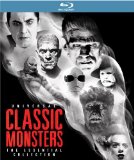| Reviews & Columns |
|
Reviews DVD TV on DVD Blu-ray 4K UHD International DVDs In Theaters Reviews by Studio Video Games Features Collector Series DVDs Easter Egg Database Interviews DVD Talk Radio Feature Articles Columns Anime Talk DVD Savant Horror DVDs The M.O.D. Squad Art House HD Talk Silent DVD
|
DVD Talk Forum |
|
|
| Resources |
|
DVD Price Search Customer Service #'s RCE Info Links |
|
Columns
|
|
|
Universal Classic Monsters: The Essential Collection
Universal // Unrated // October 2, 2012
List Price: $159.98 [Buy now and save at Amazon]
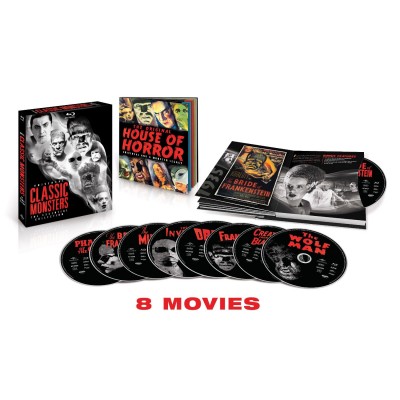
Growing up, I obviously knew about the classic monsters that appear in this set, but that was a courtesy extended to me by the costumes donned by kids and adults alike on Halloween. As far as knowing what a monster movie actually was, I was clueless. To me, King Kong and Godzilla were the closest things to monster films I had known, that is, until I was fortunate enough to catch The Monster Squad on VHS. There were Universal's most recognized monsters, all in one place - Dracula, Frankenstein's monster, The Mummy, Creature From the Black Lagoon (Gill-man) and The Wolf Man. The movie blew my mind, and I was hooked on monster cinema ever since. Reruns of The Munsters would also be partly responsible for the obsession that followed, but it was the spooky vibe of The Monster Squad that ultimately piqued my interest. Over the years, I've seen pretty much all of the Universal monster flicks that were made from 1931-1948 (much of the 50's wave escaped me), as well as a bunch of the Hammer Film iterations. Still, nothing has come close to being as atmospheric or eerie as the films in the Universal Classic Monsters: The Essential Collection, a set which I never thought would see a legitimate release on Blu-ray. There were a lot of questions and concerns floating around this particular release, but for the most part, those fears can be laid to rest.
1931's Dracula is the first film in the set, and may make some people believe this is the first Universal monster flick ever made. In actuality, the monster 'series' actually began in 1923 with The Hunchback of Notre Dame, and was subsequently followed by The Phantom of the Opera in 1925. Wondering which project would be next for the studio, Carl Laemmle Jr. (whose family founded Universal Studios) found inspiration in 1922's Nosferatu, which was an unauthorized silent film adaptation of Bram Stoker's Dracula. Bram Stoker's widow fought against the copyright infringement and demanded all original prints of the film be destroyed. With this in mind, Laemmle Jr. took the proper channels and acquired the rights to the novels in question. Dracula was on its way to becoming a feature film, but there were numerous roadblocks that threatened it from the beginning.
Lon Chaney was originally eyed to play the lead, but the film star was suffering from throat cancer and eventually passed. So, the search was on for another actor who could have done justice to the dark, mysterious creature of the night. Bela Lugosi was starring in a Broadway version of Dracula at the time and his performance was met with positive reviews, but Universal weren't interested in Lugosi in the least. In a stroke of luck, the stage production swung through Los Angeles at the right time and Lugosi campaigned hard for the role. Throwing out the idea that he would be willing to accept a mere $500 a week certainly helped to entice studio executives, as that was a gamble they were willing to take. The film was already staring down the barrel of a drastically reduced budget, as everyone in the country was severely affected by The Great Depression. However, Dracula was going to shoot for 7 weeks, and paying a measly $3,500 for the star seemed like an opportunity they literally couldn't afford to miss. Outside of financial difficulties, director Tod Browning, who originally envisioned a magnificent version of Dracula with Lon Chaney under the cape, had a severe lack of interest on the set. As a result, the film's cinematographer, Karl Freund, was left to take on much of the responsibility behind-the-scenes.
Logic would dictate that Dracula was destined to fail and put an already troubled Universal in the drink. That being said, success stories often defy logic, and this film ended up being a huge success which ultimately marked the 'true' beginning of the monster craze.
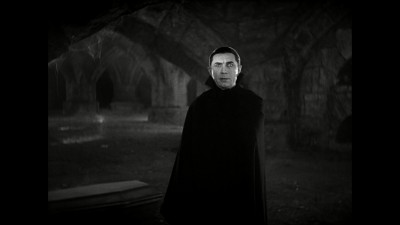
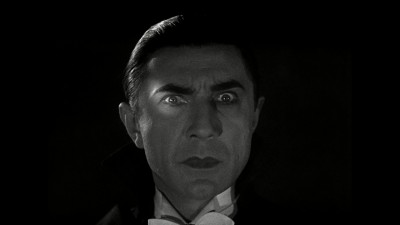
So, what saved Dracula from being a total flop? Despite the fact that Browning was less than enthused about directing the picture, to the point where he would even rip pages out of the script during production, it was the numerous decisions made in the name of artistic intent that grabbed the audience and unexpectedly bit them on the neck.
First and foremost, Bela Lugosi was masterful in his portrayal of the prince of darkness. Considering it's been 81 years since the film's theatrical release, there's been a lot of time for audiences to forget what Lugosi's Dracula was really about. Many unfortunately attribute his exaggerated accent as to what defined the character, but anyone who has actually seen Dracula knows that there was more to it than that. Lugosi spoke slowly and deliberately - The rhythm in his dialogue kept you floating with every word because it exuded so much class, but at the same time, there was something ominous about his demeanor all the same. No, it wasn't just the things that Dracula said, rather the things he didn't say. Considering how careful and precise the vampire spoke, he (it?) would often leave uncomfortable pauses in all the right places (unlike an overly dramatic Shatner impersonation). The silence is what grips me every time I watch Dracula, because it forces my mind to wander into dark territory - What's the monster thinking about, anyway? Is he savoring the moments of suspense leading up to his meal? Does the sadistic freak merely fancy a game of cat and mouse? Or is it the power he has over mortals? Sure, the answers seem obvious but I can't help but let my imagination run away with me, and isn't that what great horror is ultimately striving for? To invade your mind and clear it of all rational thought so you're more susceptible to fear? Couple Lugosi's haunting delivery with the fact that the film has no score, and those moments of silence are as uncomfortable as anything you can imagine.
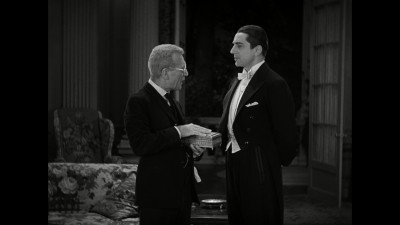
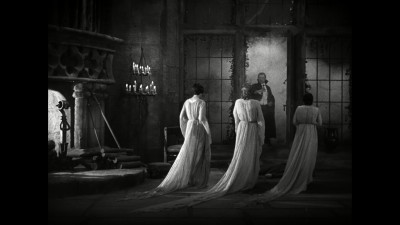
Sure, the psychological terror this film provides is tame by today's standards, but Dracula still has something that most other films don't - An atmosphere that seemingly drips from cold cobblestone ceilings, and oozes through the cracks in the floor like an invader fog. The cinematography is that good. The lighting is meticulously done and shadowing is used to play tricks on the mind. Although it's hard to imagine this film succeeding when keeping its shaky production in mind, Dracula has endured through the years as one of the most effective horror films of all time.
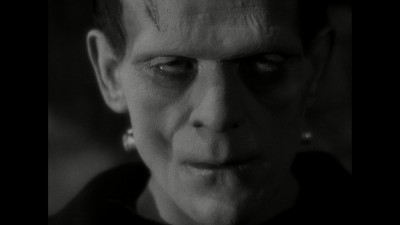
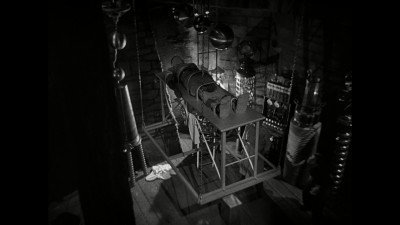
Whereas Dracula was a bit of a gamble, its success allowed the studio to have a lot of fun while promoting Frankenstein. Lugosi was originally cast to be 'The Monster', but it wasn't meant to be. As a result, people weren't sure who to expect on the big screen, and Universal took advantage of the situation - In the opening credits where Boris Karloff's name should have been, there was only a big '?'. The mystery surrounding who The Monster was going to be drew a lot of interest, making this one of the most unique pieces of B-movie advertising at the time. Hell, the studio even capitalized on reports that people were fainting during initial screenings of Dracula - The first thing we see at the beginning of Frankenstein is a friendly warning that the film may be shocking and, well, they warned us.
Of course, this opening scene also teases the most intriguing aspect of the film - The horror that's wrought when man blurs the boundary between life and death. Frankenstein, the scientist, is so excited at the prospect of playing God because he could, that he doesn't stop to think if he should. As a result, flaws in his project are abound from the beginning. First and foremost, a criminal mind is procured for The Monster. It really doesn't make much of a difference, as Frankenstein's experiment can only think on a primitive level, and this is ultimately what gets him into trouble time and time again. When he sees someone carrying a torch for example, the fire causes The Monster to act in self defense. His creators don't understand he's frightened and trying to protect himself, so they chain him up. Of course, this doesn't make The Monster feel at ease, so his rage only grows. Before he knows it, the whole town is chasing after him with torches and pitchforks.
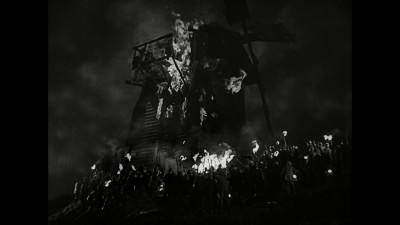
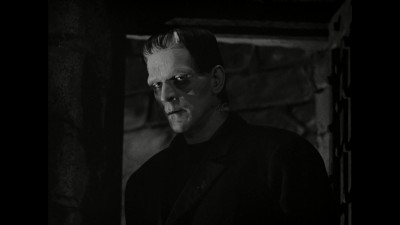
The 'should or shouldn't' debate is one of my favorite philosophical sci-fi themes of all time. Frankenstein was really ahead of its time in this respect, and the concept is just as relevant today as it ever was, if not more so. This film is a great example as to why we shouldn't meddle with things we don't fully understand, because we're not usually prepared to handle the issues that arise when we open Pandora's box. As the film so accurately depicts, human beings have a tendency to lash out against things they don't quite understand. It's this all around ignorance that makes the film so horrifying - Playing God with limited knowledge clearly has its consequences, yet humanity tends to lose sight of that when their ultimate goal is fueled by good intentions. Although The Monster is clearly misunderstood, again, his good intentions are just as deadly as Dr. Frankenstein's. The imperfections of the creator are magnified in his creation, and when The Monster is unleashed amongst the townspeople, those flaws prove to be deadly. The creepiest thing about this film isn't exactly the horror The Monster brings to the world, but rather the fact that we sort of feel sorry for him in the end. The Monster did not ask to be pieced together from the dead and reanimated - No, for all the trouble he brings to those around him, he's basically an innocent.
Boris Karloff, although covered in makeup and barely recognizable, really drives this point home in his portrayal of The Monster. With someone who didn't really understand they were playing a confused 'innocent' as opposed to a 'monster' in the truest sense of the word, this film probably would have flopped. However, Karloff is able to grip our intellect and emotions in his portrayal of Frankenstein's Monster, and being as how the monster never speaks, that says a lot.
Much like Dracula before it, the set designs play an integral role in the film's atmosphere. As a matter of fact, this film is home to one of the most iconic set pieces of all time - The Monster's creation scene in Frankenstein's lab, complete with working Tesla Coils that were acquired by Kenneth Strickfaden. A windmill burning on a distant hilltop is just as iconic. Outside of Strickfaden's 'electric' effects, Arthur Edeson's haunting cinematography and Jack Pierce's make-up really help to up the terror. I know many may not agree with me, but Frankenstein is a bit deeper than your typical monster flick, and it stands as one of my personal favorites in this collection.
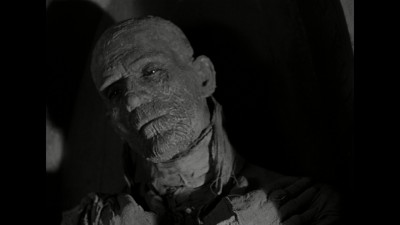
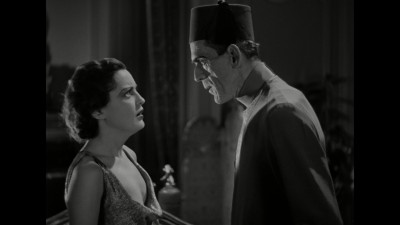
When talking about Universal's iconic monsters, it's The Wolf Man that tends to round out what I like to call 'the classic trio', but it was actually The Mummy that terrorized audiences first. In 1922, King Tutankhamen's tomb was opened by an excavation group led by Howard Carter. When members of the team began to die in mysterious ways, well, public interest really went through the roof. This interest, as well as the finding of ancient texts, cultivated the superstition that bad things would happen to those that dared to enter a sealed tomb, which subsequently became known as the 'Curse of the Pharaohs'. This was the inspiration for The Mummy, and who better to play the part than Mr. Monster himself, Boris Karloff?
If you've seen the 1999 version The Mummy, then some of the film's plot may seem familiar to you. However, make no mistake about it - This is thankfully a very different film. I'm aware there are many people today who have yet to experience the wonders of the Universal Monster films, so I'm not going to risk giving too much away, but this is more or less a twisted love story. Unfortunately, it bears a striking resemblance to Dracula - The monster uses his eyes to compel people to do his bidding, and assumes human form to make the effort of lulling people into false security that much easier. Furthermore, Edward Van Sloan appears in both films with similar roles. Last but not least, Universal chose Karl Freund (the cinematographer turned director on Dracula) to take the helm. It was obvious that the studio was trying to replicate the success it had with Dracula. This was a very dangerous move by the studio, if you ask me. Obviously my sensitivities aren't in tune with what the public's expectations were like in the 30's, but is building a new franchise on a similar story to what was in theaters only a year before ever a good idea? Universal sure seemed to think so, but were they actually able to pull it off?
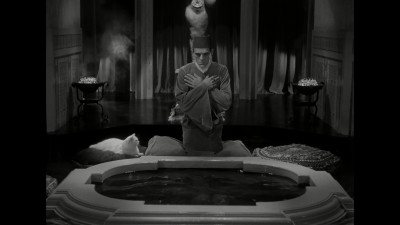
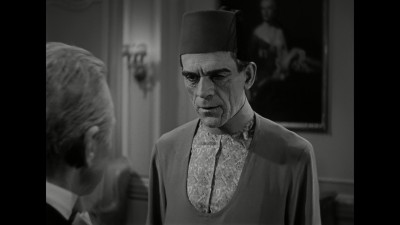
In my opinion, The Mummy, although a fine film and memorable in its own right, doesn't live up to the standard that Dracula set before it. The story about an ancient Egyptian priest coming back to life in the modern age and searching for the reincarnated version of a lost love is a fresh enough twist, but its goal of replicating Dracula holds the film back from being everything it could have been. Still, Boris Karloff is able to show off a bit more of his acting chops than before, and it's hard to imagine another actor of the time fitting the bill so flawlessly. Jack Pierce was once again responsible for the make-up, and his painstakingly detailed work is still quite impressive even by today's standards. Of course, Karloff wasn't a big fan of the 8 hours it took to apply, especially since it hurt so much to remove, but the end result is obviously worth it. The lighting and cinematography is, once again, so integral to the overall tone of the film that they're practically their own character. It's another great addition to Universal's monster series, for sure, but the blatant lack of originality keeps it from being a great film.
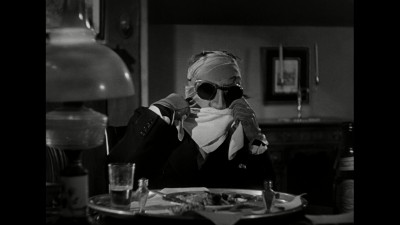
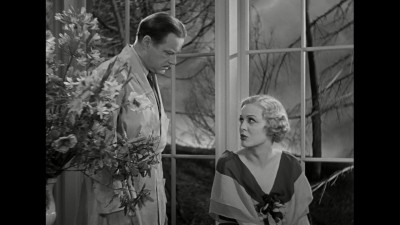
The things that happened prior to production boggles the mind - Boris Karloff did a magnificent job as Frankenstein's Monster and continued to deliver in 1932's The Mummy. It was no surprise that the studio wanted Karloff to play the lead in yet another shocking tale, but for some reason, Carl Laemmle Jr. repeatedly try to cut Karloff's salary and pushed the star away. The monster series was proving successful for the studio, and Karloff was proving to be the perfect casting choice for any film they were drawing up for the genre. So, why chase him away? Why try to cheat him out of what he was contractually obligated to receive? It makes no logical sense, but fortunately for everyone involved, Claude Rains was perfect as the chemist whose life was quickly spiraling down the drain, and I honestly can't imagine The Invisible Man without him.
As mentioned previously, I have a vast appreciation for sci-fi/horror flicks that question the morality of science ('could' versus 'should'). The Invisible Man, much like Frankenstein before it, uses this theme as the 'why' behind the madness, with the exception that this time, the main character has actually turned himself into a monster. Dr. Jack Griffin has stumbled upon the secret of invisibility, but its key ingredient is the dangerous chemical monocane, which has been known to drive animals mad. Excited over his scientific find, Dr. Griffin ignored this discouraging information and tested the formula on himself. His recipe for invisibility worked, but it also tainted his brilliant mind. He quickly shifts from a rational intellectual to a mad scientist playing by his own rules... and he intends to keep it that way by using his newly discovered power to take over the world. That's a horrifying thought to entertain, isn't it? That the most brilliant person in the world has lost his mind and intends to use his intellect for pure evil? I mean, how do you stop a guy like that, especially if he's invisible? The short answer is you probably can't, and if by some small miracle you're able to, the body count is bound to accumulate wildly before doing so. This is the kind of experience The Invisible Man delivers in spades.
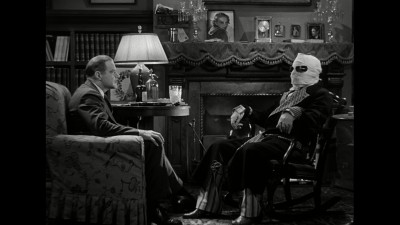
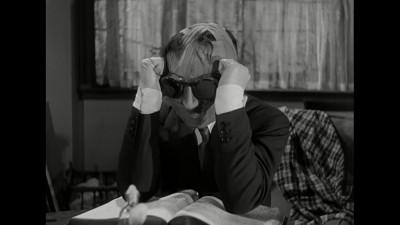
As far as how good this film is compared to its predecessors, I still have to give the nod to Dracula and Frankenstein as they far exceed this film in terms of set design and cinematography. Still, because The Invisible Man actually produces a multi-layered villain to examine, it remains a serious contender because it's far less predictable. I'm a big fan of character study and Dr. Griffin is the earliest cinematic example of a struggling monster I've ever seen. In this respect, The Invisible Man, much like Frankenstein, was way ahead of its time. When monocane is introduced into Dr. Griffin's system, an intense battle of duality begins and drives this monster flick to be just as much a psychological horror as anything else. There are times when the human side of Dr. Griffin comes to the surface, but as the film goes on it becomes blatantly obvious his humanity is dissipating at an alarming rate. To a certain degree, I felt like I was struggling with some duality within myself while watching the film - Dr. Griffin never asked to have his life ruined by his miracle invention, so sometimes I feel like it's reasonable to feel sorry for the poor guy. At the same time, I feel like he's undeserving of my sympathy because ultimately, he should have known better than to use himself as a test subject. The way this film toys with my emotions is quite the rollercoaster ride, and it's easily the best thing this film has to offer.
I mentioned that the cinematography and use of lighting wasn't as impressive in this film, but there's still a major aspect of this classic that more than makes up for it - The special effects. The first time I saw this film, I was amazed at how the filmmakers were able to make such a convincing invisible man. Sure, a fair chunk of the film features someone that's heavily dressed and completely wrapped in bandages, but there are plenty of moments where my jaw hung to the floor wondering, "How could they have done that in 1933?" For those that haven't been too spoiled by the CGI we've grown accustomed to, you'll likely find the special effects in The Invisible Man to be amongst the most appreciable in the entirety of this collection.
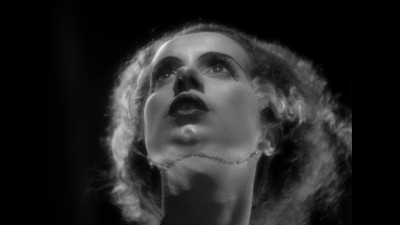
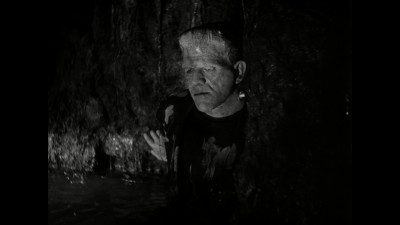
Universal - happy with Dracula's success and pleased with the positive word circling around Frankenstein's preview screenings - were eager to start work on another film featuring Frankenstein's Monster in 1931. However, the original director, James Whale, didn't feel like Frankenstein warranted a sequel. The studio contemplated making the film without him, but Whale's The Invisible Man was so well received, they knew he was the only man for the job. The director used this as leverage to make a deal with the studio - If they allowed him to direct One More River, he would help them make the sequel they so desperately wanted. The studio granted Whale his wish, but that was only the beginning of the film's troubled pre-production. No, Whales wanted to make The Bride of Frankenstein something of 'a hoot' (his words, not mine), but that's not to say he wanted to make a crap film. On the contrary - Numerous scripts were rejected over the years until Whales finally read a treatment he liked in 1934. So, how does Universal's first official monster sequel fare?
The Bride of Frankenstein is very different from its predecessor, to say the least. Whereas Frankenstein explored lessons about scientific morality, Bride changes things up and focuses squarely on a rampaging monster instead (for the most part). This wasn't the kind of thing that compelled me to keep watching the original Frankenstein, but considering what the townspeople did to The Monster, I suppose his fits of rage are justified. Keep in mind, he feels like people will hate him no matter what he does, so his primitive mind figures he should go on the offensive for the sake of self preservation. Watching The Monster do his thing is entertaining and all, but it's not my favorite part of the film. What piques my interest the most is that Dr. Frankenstein has come to the realization that his creation is an abomination, yet like any obsessed scientist that's close to unlocking the secrets of immortality, he still considers his Monster to be a necessary evil. The only problem is that his Monster is wreaking havoc and can no longer be controlled. Coincidentally, Dr. Frankenstein's old mentor shows up and presents him with a feasible solution - Tame The Monster by providing him with a mate.
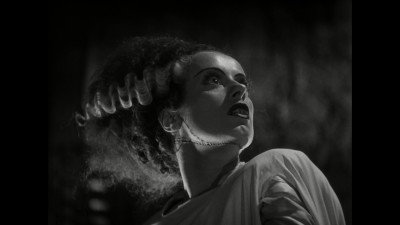
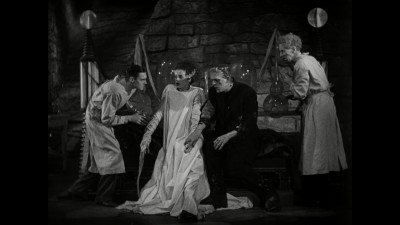
This is where things begin to get... oh, 'interesting'. The Monster makes friends with a blind hermit who teaches the lumbering giant how to communicate. Yes, as in using words to talk. Boris Karloff had a big problem with the logistics of such an idea, so a research team took The Monster's 10 year old mentality into consideration and came up with a list of 44 basic words he'd probably be able to learn. So, yes, Frankenstein's Monster eventually speaks. As blasphemous as the idea is on paper, it actually works quite well in practice. The Monster doesn't say much, but in the end, the words he does use have a chilling effect on the film as a whole. The message he conveys is that human beings have a nasty habit of labeling things they don't understand, and although they consider him to be a 'monster', human beings are probably the biggest monsters of all... especially those who have been corrupted by their desire to obtain the unobtainable.
So, I wouldn't exactly say that The Bride of Frankenstein is the 'hoot' that James Whale promised it would be. Yes, the film is loaded with genre satire - Instead of one monster, there are two. Instead of utilizing the slow burn technique for a chilling plot, Frankenstein's Monster spends a great deal of time running amok. Having him speak is a stretch especially, but the film never borders slapstick territory. In fact, it's not even close. The script is intelligently written with lots of dark, subtle comedy and wit, and the direction and cinematography is masterfully executed. The sound design, make-up and special effects all culminate once again for an eerie assault on our senses. Karloff is, of course, brilliant as Frankenstein's Monster and Elsa Lanchester is just as iconic as his bride. This film is just as good as the original, albeit for very different reasons. It's not the best straight-up monster flick, but it's certainly one of the most well-rounded and entertaining. Just so I'm clear - This is one of the best films this set has to offer.
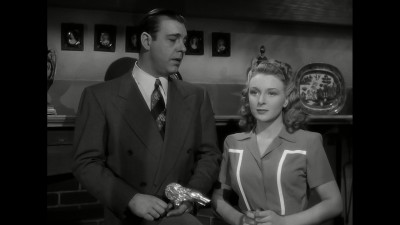
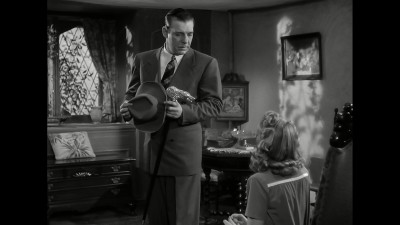
In the 40's, there was a second wave of monster flicks released by Universal, and after a slew of Invisible Man and Mummy sequels, audiences were ready for something they could really sink their teeth into (pardon the pun, I couldn't help myself). Universal Studios gambled in 1935 with Werewolf of London, but many thought it was too similar to Dr. Jekyll and Mr. Hyde, so the film ultimately flopped.
As a side note, I get a kick out of seeing how inconsistent the public can be. As I've already mentioned once, The Mummy had borrowed quite heavily from Dracula, yet nobody seemed to care.
Anyway, Universal was ready to give werewolves another shot. The studio knew there was so much more they could milk out of the monster genre, and with Lon Chaney Jr. stepping into The Wolf Man's shoes, they also knew people would probably show up to see the film no matter what. This time, their gamble paid off and The Wolf Man is one of the top three classic Universal monsters of all time.
The plot is fairly simple, but highly effective - Larry Talbot returns to his home town to mourn the loss of his brother and hopefully reconcile with his father. Late one evening, he saves a young woman from a wolf but doesn't walk away unscathed - A bite to the chest is revealed to be more than a flesh wound; the beginning of a curse which will transform Mr. Talbot into a werewolf whenever the wolf bane blooms. And so the horror begins.
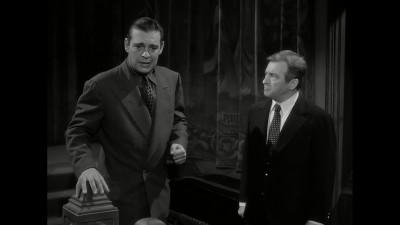
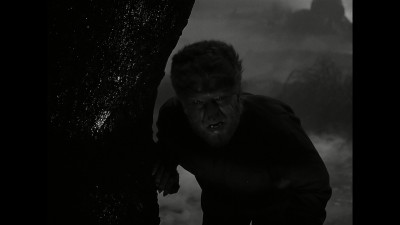
Like the best of Universal's classic monster films, The Wolf Man is comprised of equal parts psychological horror and monster flick. As far as the 'monster flick' portion is concerned, Chaney Jr. pulls off the monster effortlessly, and these scenes are heightened further by the film's creepy atmosphere - Obviously, the werewolf attacks at night, and this dark setting is accompanied by emulated moonlight, thick fog and some of Jack Pierce's best make-up yet. As a result, this film is just as moody as Dracula or Frankenstein.
As far as the psychological part of the film, I love watching Talbot (Chaney Jr.) wake up and realize he's attacked the innocent in the middle of the night. You see, unlike The Invisible Man who was slowly descending into madness, Talbot has absolutely no control over his newly acquired dark side. So, when Talbot wakes up, terror and dread fill his because he can't remember what happened the night before. All the same, he knows the werewolf inside took control and killed someone. Hell, perhaps someone he cared about. So, Talbot spends a good deal of time racing against a ticking clock, trying to find a cure before night falls once more. Lon Chaney Jr. was seemingly made for this role, and audiences over the years seem to have agreed. As a result, Chaney Jr. was Universal's new 'go to' guy for monster flicks.
After your initial viewing, I'm sure you'll agree that The Wolf Man is a hell of a film. It has that drippy atmosphere that made Universal's earlier efforts so palpable, and the scenes featuring The Wolf Man are quite the sight to behold. The story sat in the pit of my stomach because I dreaded that this poor guy, who was only trying to save a girl from a wolf, probably wouldn't make it to the end of the film (that's just the vibe I got the first time around). You'll have to see The Wolf Man yourself to see what happens, but it's an intense ride and one of my favorites in this collection.
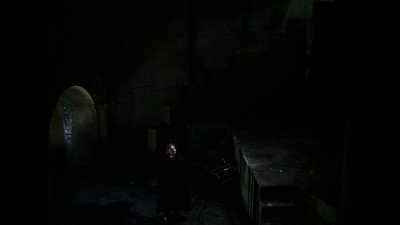
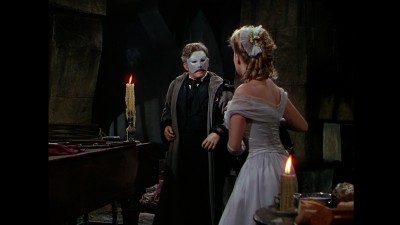
Chances are, if you Google Universal's 'The Phantom of the Opera', you're going to find a lot of information on the 1925 version starring Lon Chaney. It's black and white, oozed atmosphere, and featured a monster that could only have appeared in a Universal genre flick. Furthermore, it debatably has the most historical significance in regards to the genre as a whole, as it was partly responsible for starting the monster craze. Surprisingly, the 1925 Phantom isn't included in this set. Instead, we're given the 1943 version, and this undoubtedly has a lot of people scratching their heads. I have never seen the '43 iteration before receiving this set, so I was as skeptical as the rest.
That being said, The Phantom of the Opera is actually a decent film. It's my least favorite entry in this collection, but a decent film nonetheless. My guess is a lot of people are going to be put off by this film for a couple of reasons - One, this film is in color and when people think 'Universal monsters', they don't think about their films in color (unless you somehow managed to catch a screening where certain parts of certain films were actually tinted). Two, this isn't the version of the film everyone was hoping to see in HD. Me? I'm coming from a completely different place in my assessment. My main complaint is that the film is far too choppy, even at a mere 92 minutes. The opera scenes are much lengthier than they should be and suck the tension out of the film. The filmmakers were seemingly trying to draw things out so we would sit on the edge of our seats, waiting to see what might happen at any given moment. Still, the rest of the film doesn't utilize the same slow burn technique so the opera sequences feel out of place.
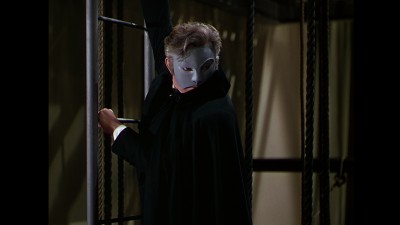
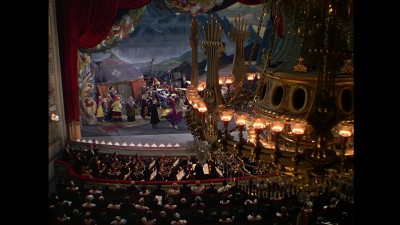
That nitpick aside, The Phantom of the Opera is still very much worth watching. Despite the numerous lulls contained within, the rest of the film is pretty intense and the cinematography is far more elaborate than I imagined it would have been. The best part of this film is undoubtedly the return of Claude Rains, as he once again provides us with the perfect portrayal of a man who's slowly succumbing to madness. If you're curious if I'm merely blowing smoke because I'm a big Universal monsters fan, go and take a look at Andrew Lloyd Weber's version of Phantom, and you'll suddenly understand the historical significance of this film. It can be said that this version of Phantom is what helped shape this 'monster' into the character everyone is familiar with today. It's really no surprise why Universal chose this film over Chaney's 1925 classic (besides the fact that Image Entertainment currently have distribution rights). Give this a shot, and you'll probably be surprised at how good it actually is. Take it from me - I'm not a fan of Weber's Phantom as it's unrealistically romanticized, but I found this film to be a much easier pill to swallow.
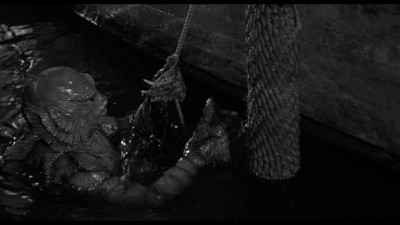
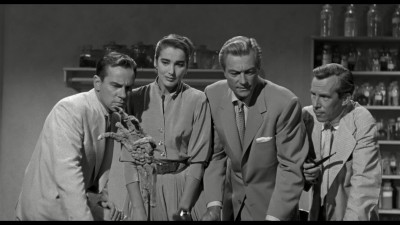
Last but certainly not least, this boxed set ends with Creature from the Black Lagoon. In the later 40's and early 50's, the monster craze was losing life and fast. The genre wasn't performing as well as the original classics, and Abbott and Costello got in on the action and starred in no less than four monster-comedy mash-ups. There didn't seem to be any more room for truly legitimate monster films, at least, ones that would produce a monster that audiences would remember for the rest of time, but that all changed when this film was released.
The plot of Creature is amongst the most basic in this collection - Fossilized evidence reveals there was a creature that seemingly had a skeletal hand with webbed fingers. An astonishing geological find, an expedition is set to return to the Amazon so the rest of the skeleton can be found. Of course, the crew eventually comes face to face with the Gill-man they thought to be long extinct. Instead of approaching the creature with caution, they prematurely attack so the monster goes on a rampage and kills everyone in sight. The rest of the film focuses on the hunt for Gill-man, and since we obviously can't have a great monster hunt without a damsel in distress, a beautiful leading lady has been thrown into the mix for good measure.
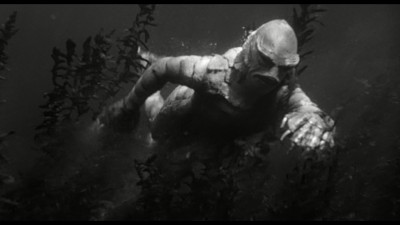
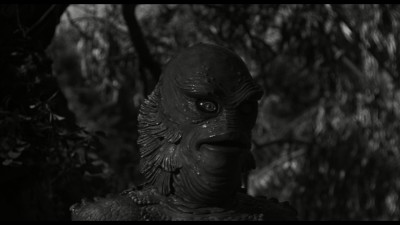
I know it doesn't sound very exciting, but Creature from the Black Lagoon actually does everything right. All you have to do is take a look at the Gill-man suit to understand why - It's phenomenal. Although it's painfully obvious by today's standards that all we're watching is a man terrorize people in a rubber suit, the attention that's been paid to detail is really second to none. To enhance the realism of this 'Gill-man', the suit was filmed not just on dry land, but it water as well. Many say that Jaws was the film that was responsible for keeping people out of the water, and although that's true enough for more recent generations, I wouldn't be surprised to learn that this Creature had a similar effect on people back in the day. This also isn't one of my favorites in the set, but there's an undeniable charm about the film's presentation that I've never been able to shake.
****Before continuing with the subsequent portions of this review, it should be noted that this screener set accidentally included two copies of The Bride of Frankenstein, and The Invisible Man was nowhere to be found (oh, the irony). I was able to obtain a copy of the missing disc from a friend for the sake of this review, so I wouldn't say this is a widespread issue (there haven't been such reports on the internet of duplicate discs either, except from other review sites). We have contacted the studio and this review will be updated if and when there's resolution.****
All encoded at 1080p via the AVC codec (minus Creature from the Black Lagoon, which was encoded with MVC for its 3D version), the films in this collection have been lovingly restored. That's not to say that all the titles are perfect without any issues whatsoever, but the majority of the films in this collection look as pristine as they ever will.
Without question, the best looking titles are Dracula (1.35:1), Spanish Dracula, Frankenstein (1.35:1), The Mummy (1.37:1), and The Bride of Frankenstein (1.35:1). Unlike the previous DVD releases - which featured washed out contrast and black levels, as well as a sigh-able amount of softness and print damage - these Blu-ray restorations are literally the difference between night and day. Black levels and are finally deep and inky, and this has been accomplished without crushing details into dark oblivion. No, the varying degrees of black differentiate themselves remarkably and midrange grays appear exactly as they should. The contrast overall is immaculate and actually surprised me, as the lighting is now more effective than I've ever seen. I'm only 30, but the blacks and contrast alone really made me feel like I was watching these films for the first time. The palpable atmosphere on display in these films has been dramatically intensified by these changes, and you'll likely feel the 'mood' these films were striving to achieve more than ever before. Yes, there are still some vertical lines, scratches and specks, but for films that are the better part of a century old, I guess that's to be somewhat expected, no? And the technical presentation on these films are near flawless - Although there's some principle photography that leans on the soft side now and again, edges are sharp more often than not. Also, film purists will be happy to hear that there's no digital anomalies such as edge enhancement or digital noise reduction. These movies looks like film, and I would be hard pressed to believe there's anyone out there who won't be impressed by what they see.
The subsequent films have their share of imperfections, though. They're still night and day to their DVD counterparts, but when compared to the films mentioned in the paragraph above, they leave something to be desired.
Going chronologically, The Invisible Man (1.37:1) is almost on par with the likes of Dracula and Frankenstein, but there's some minor artifacting that occurs in the background. Still, it's nothing that comes even close to being offensive, but it's there nonetheless. Soft photography appears with a bit more frequency, although I can't really fault the transfer for that. Some scenes look like they may have had a little DNR applied to keep the image balanced, but there's still a fine structure of grain present, so I'm inclined to believe Universal was very careful with its application.
The Wolf Man (1.36:1) isn't exactly worse for wear either, and in fact comes close to being as impressive Dracula. Unfortunately, there's definitely a bit of edge enhancement that can be seen throughout and it's likely to even catch the eye of those who aren't normally sensitive to such things. Otherwise, the rest of its technical presentation is over the moon. Similarly, Phantom of the Opera (1.36:1) has the same sort of thing going on as well - The transfer is gorgeous more often than not and its color saturation is impressive, but there's still some lingering edge enhancement to be seen.
Unfortunately, Creature from the Black Lagoon (1.85:1) is the least impressive title in the set, visually speaking of course. The restoration was probably as thorough as it could have been, but the condition of the source seems more inconsistent than the rest. That's not to say this movie looks bad, because it doesn't - There's just plenty of inherently soft photography, larger 'chunkier' grain on occasion and yes, there's edge enhancement to be found here, too. As far as compression is concerned, there's some minor macroblocking and even a little banding. This Blu-ray still blows the DVD out of the water though. As far as the 3D version is concerned, I didn't have the opportunity to watch it in its entirety, but I did sample half an hour or so at a friend's house (professionally calibrated 3D setup at his house, lucky duck). I have to say, it looks pretty convincing. The 3D isn't exactly a revelation, but it's really nice to see such an old film that was filmed with the intent of being viewed with polarized glasses, get a home video treatment in such a classic collection of films. This is probably going to be the highly of many Creature feature fans, and I certainly can't blame them.
Overall, Universal has done the best job they could considering the condition of the source materials they had to work with - Half of the films (more than half if you count the Spanish version of Dracula) look pristine, whereas the other monster flicks, while still strong enough in their own right, have some minor issued that can be overlooked. If you were concerned as to whether or not these films could really benefit from an HD upgrade, the answer is a big, howling 'yes'. As I've already said once before, you're going to feel like you're watching these films for the first time.
All of the films in this collection can actually be grouped together in terms of how good they sound. All presented with a DTS-HD Master Audio Mono track, these monster flicks sound great across the board. These films had some very unfortunate background noise and hissing, and the restoration team really had to be diligent to try and nullify that effect as much as possible. The end result isn't perfect, but the clean-up efforts are still impressive nonetheless.
Dracula is probably the most impressive audio restoration on the set, as it does a fantastic job at decreasing the noise and hiss to a level that isn't really bothersome, and they've done an even better job at isolating and pulling forward some of the sound effects that were previously drowned out by the noise in the track. Frankenstein is probably the least impressive presentation in the box in terms of audio though, as its audible noise and hiss, although drastically reduced, isn't quite up to snuff when compared to Dracula. Furthermore, the dialogue also had a tendency to sound somewhat tinny at times and even a little muffled.
The rest of the films had a bit less noise on the track originally, at least when I go back and listen to my old DVD's, so it wasn't as hard to make them sound as pristine (although I don't discredit the amount of work that had to go into those films). So essentially, the further we move along chronologically, the better the films sound. Phantom of the Opera is probably the most pleasant experience of the bunch, and its operatic sequences although detrimental to the pace of the film, are amongst the most impressive sounds you'll hear. Continuing to speak generally about all the films in this set, the dialogue can be inconsistent and still sound slightly muffled from time to time, but considering the shape each source was in, there's no doubt in my mind they couldn't be made to sound any better than they do now.
Minor issues aside, this set sounds much better than I anticipated it to be, and again, the difference between the Monster Legacy DVD's and this Classic Monsters set is quite literally night and day.
What a great looking set - The box art online is a little deceiving, as it leads us to believe that the image is merely black and white. Now that I have this set in my hands, the art actually has a smoky silver look and helps to enhance the atmosphere that's trying to be conveyed. The outer box itself is also thick and sturdy, much like the Alien Anthology box.
There are three pieces inside the box - First, there's an advertisement for the upcoming Hitchcock Blu-ray set, which was due at the end of September but has since been delayed to late October (to address some quality control concerns). Next, a well designed 46 page booklet that features tons of information about each of the films, as well as some of the vital stars, directors and even makeup artist Jack Pierce. The main attraction is a thick, cardboard style book which houses the discs. Each page features the film's original poster art on the left, with some well known imagery of the monster in action as well as a listing of bonus features on the right.
A lot of people assumed this book would be like the Alien Anthology style packaging, despite preview pics showing us otherwise online. Some people might be asking, "What's the difference?" And it all comes down to how the discs are actually stored in the cardboard pages.
In the Alien Anthology, the discs were actually placed in the center of a cardboard page, and the designers were good enough to leave a tab open for our pointer finger to grab the outside of the disc, and also left enough room for us to grab the center of the disc with our thumb - This made it easy to remove our discs without touching the data layer beneath. It was a safe and intuitive design, and (mostly) everyone was happy.
The pages in this set however, have a slot open on the side of each page. Discs have more room to slide around as a result, and it's difficult to remove the discs at times without touching the bottom. Furthermore, a few of the discs in my set had glue from the packaging stuck on them. Not exactly something you want to have coming loose inside your player, so clean diligently. For a complete look at this set, I have provided an unboxing video:
-Dracula - The Restoration - This is amazing little featurette. It's only 9 minutes in length, but it details the restoration from the original film and audio flawlessly. There isn't a lot of technical jargon or boring filler here - Everyone at home, regardless of their knowledge of film, will be able to walk away with an appreciation for film restoration. Furthermore, it will solidify your appreciation for this boxed set that much more.
-Dracula Spanish Version - As anyone who is already familiar with this film knows, the Spanish version of Dracula was filmed at night on the same sets that the Bela Lugosi starring version utilized during the day, so you're bound to recognize the costumes and sets. Dracula is not unique in this treatment, as the studio did this fairly often with its films as a way to keep costs down while still ensuring their films reach as broad an audience as possible. Some consider this 'night' version of Dracula to be superior, and I think in terms of its atmosphere, filming at night really helped to give this film that reputation - It does seem superior in this respect. However, the Lugosi starring Dracula is still my favorite because, let's face it, Lugosi is Dracula. In the end, it all comes down to this - If you're a fan of these monster horror classics, watching the Lugosi version isn't enough. The Spanish Dracula is very deserving of its high praise and should be screened by everyone. And yes, this version has also been lovingly restored and presented in wonderful HD.
-Audio Commentaries - With Film Historian David J. Skal / With Dracula: Dead and Loving It Screenwriter Steve Haberman - Well, both commentaries were fairly tough to sit through. Don't get me wrong - Both David J. Skal and Steve Haberman present a lot of great information, and that says a lot because I really didn't expect much from the writer of Dracula: Dead and Loving It, but their presentation is about as dry as it gets. Anyone who is interested in classic film really should set aside some time for these since they do offer a great wealth of information, but those who are weary of audio commentaries to begin with will probably find themselves bored to death (no pun intended, this time).
-Alternate Score Track - Philip Glass and the Kronos Quartet orchestrated a score for Dracula in 1998. It absolutely sounds like blasphemy, but this score is actually very effective. It's appropriate and never over the top unless the film actually calls for it to be. That being said, Dracula drew strength from its initial silence, and the theatrical cut is still my preferred way of viewing this film.
-The Road to Dracula - 35 minutes in length, this behind-the-scenes featurette (hosted by Carla Laemmle) is a nice little 'bite' of history. Many big names in modern horror filmmaking show up to tell us what they know, and film historians are also included to make sure we get as much information as possible, in as entertaining a way as possible.
-Lugosi: The Dark Prince - Around the same length as the above listed featurette, this one focuses squarely on the career and life of Bela Lugosi.
-Dracula Archives - You'll see a similar 'archives' feature on each subsequent disc in the set, and they all feature a nice collection of promotional art, production stills and other pieces of the films histories.
Also included - Trailer Galleries and Monster (Trivia) Track
-The Frankenstein Files - How Hollywood Made a Monster - This is a great 45 minute documentary hosted by film historian David J. Skal. This covers pretty much everything from Mary Shelley's classic tale to the film's influence on cinema after its release. Well worth the time.
-Karloff - The Gentle Monster - Without Boris Karloff and his portrayal of Frankenstein, the bar could have remained pretty low for the monster films to follow. Much like the Lugosi featurette on Dracula, this 38 minute doc covers the career of Karloff and is a fascinating entry the slew of extras this boxed set provides.
-Universal Horror - This documentary clocks in at a little more than an hour and a half, and filmmaker Kenneth Branagh (Mary Shelley's Frankenstein, Thor) hosts us through Universal's entire legacy of horror. Do I even have to say that horror fans shouldn't miss this one?
-Audio Commentaries - With Film Historian Rudy Behlmer / With Film Historian Sir Christopher Frayling - Much like the Dracula commentary tracks, there's a great wealth of information but most of it is presented dryly. That being said, Sir Frayling does break away from his notes to interject thoughts that come to mind along the way, making his experience the more personable and enjoyable.
-100 Years of Universal - Restoring the Classics - This featurette covers the restoration for all of the films in this set. It's only 9 minutes in length though, so it isn't as revealing as the mini-doc that was included with Dracula, but newcomers to the technical processes to achieve a product such as this will still find it to be informative enough.
-Boo! - A Short Film - This short film is a parody by Albert DeMond.
-Frankenstein Archives
Also included - Trailer Galleries and Monster (Trivia) Track
-Mummy Dearest - A Horror Tradition Unearthed - This is an intriguing featurette (30 minutes), but I take certain issues with the material that's presented. My biggest complaint is that they really try to sell how unique this film was, yet everyone who was involved with The Mummy knows it wasn't really that unique. It was similar to Dracula in many ways, although the film did have some tweaks to keep it feeling fresh. Still, this is a great doc about a classic horror film and shouldn't be missed.
-He Who Made Monsters - The Life and Art of Jack Pierce - Jack Pierce is mentioned multiple times throughout this review for his efforts, as he's responsible for bringing many of the classic monsters to life. The fact that this guy has his own little featurette is well deserved.
-Audio Commentaries - With Make-up Artist Rick Baker, Filmmaker Scott Essman, Screenwriter/Film Historian Steve Haberman, Collector Bob Burns and Brent Armstrong / With Film Historian Paul M. Jensen - If it's pure information you want, stick with the second commentary track... but be warned, it's a lot to take in and probably the most dry presentation in the collection yet. The first commentary track is a little excessive (as in, how many people are involved) - The film historian predictably has the most to say, but at least the other contributors keep things from feeling dull.
-100 Year of Universal - The Carl Laemmle Era - Carl Laemmle was the founder of Universal Studios and this featurette pays tribute to his vision and contributions.
-Unraveling the Legacy of The Mummy - A short piece that gives credit to those who were responsible for bringing this classic monster to the big screen.
-The Mummy Archive
A Trailer Gallery is also included.
-Now You See Him - The Invisible Man Revealed - This 35 minute documentary, hosted by Rudy Behlmer, pulls contributions from various names in the biz (actor Ian McKellen, film historians, horror buffs, etc) and details everything about the film, from pre-production on. Fascinating piece.
-Audio Commentary - With Film Historian Rudy Behlmer - Another highly, highly informative commentary track that's also really, really dry. Just so I don't come off as someone who hasn't been appreciating these documentaries, I'dl like to make something clear - I actually have a great amount of appreciation for them, and I know there's only so much that can be done for films that are this old, but reading notes and essays and whatnot can be difficult for the listeners to sit through.
-100 Years of Universal - Unforgettable Characters - This actually covers more than just the classic horror characters, surprisingly enough. But, this is Universal's 100 year anniversary and I guess I should have expected something a little more all encompassing. Still an interesting watch, though.
Also included are some Production Photographs and a Trailer Gallery.
-She's Alive! - Creating the Bride of Frankenstein - Filmmaker Joe Dante (Gremlins) goes over every aspect of the film in this 39 minute doc. It's a highly intriguing breakdown, which can probably be contributed to the unique was in which this film was approached. This is a must watch.
-Audio Commentary - With Film Historian Scott MacQuenn - Again, another reading that's highly informative, yet also very dry.
-100 Years of Universal - Restoring the Classics - This featurette covers the restoration for all of the films in this set. It's only 9 minutes in length though, so it isn't as revealing as the mini-doc that was included with Dracula, but newcomers to the technical processes to achieve a product such as this will still find it to be informative enough.
-The Bride of Frankenstein Archive
A Trailer Gallery is also included.
-Monster by Moonlight - John Landis (An American Werewolf in London) hosts this documentary covering the film's entire history. Much like the documentaries covering such a topic on the previous discs, it's highly informative and easy to watch.
-Pure in Heart - The Life and Legacy of Lon Chaney Jr. - Much like Boris Karloff before him, Chaney Jr. was the next truly big name in Universal's horror line-up, and his life and career is detailed here.
-He Who Made Monsters - The Life and Art of Jack Pierce - Jack Pierce is mentioned multiple times throughout this review for his efforts, as he's responsible for bringing many of the classic monsters to life. The fact that this guy has his own little featurette is well deserved.
-Audio Commentary - With Film Historian Tom Weaver - This commentary is a mixed bag - There's a lot of information that's read like in most other tracks in the set, but the film historian does break in his own thoughts and musings as well.
-From Ancient Curse to Modern Myth - The influence this film has had and why it was so effective.
-100 Years of Universal - The Lot - Universal's back lot is infamous and is the home of many famous films. This 10 minute piece reveals it in full and details its significance.
-The Wolf Man Archives
A Trailer Gallery is also included.
-The Opera Ghost - A Phantom Unmasked - Film Historian Scott MacQuenn hosts a detailed look at not just this particular film, but of Phantom in general and the impact it's had on various platforms over the years.
-Audio Commentary - MacQueen is looking to be a one man show, as he's also the one who sits down for this commentary. Much like the rest of the tracks (broken record, I know), it's highly informative but fairly dry.
-100 Years of Universal - The Lot - Universal's back lot is infamous and is the home of many famous films. This 10 minute piece reveals it in full and details its significance.
Production Photographs and a Trailer Gallery are also included.
-Back to the Black Lagoon - This is another great classic horror doc about the film featured on the disc. Film Historian David J. Skal hosts and discusses everything about the film's inception through to its impact on filmmaking ever since.
-Audio Commentary - With Film Historian Tom Weaver - This is probably the second most entertaining doc across the entire set, despite still having a heavy dose of notes being read aloud.
-100 Years of Universal - The Lot - Universal's back lot is infamous and is the home of many famous films. This 10 minute piece reveals it in full and details its significance.
Production Photographs and a Trailer Gallery are also included.
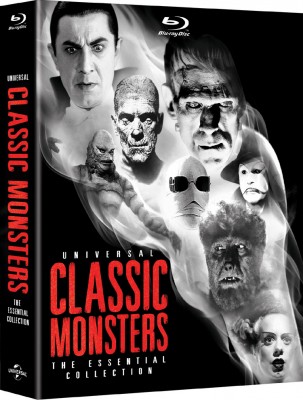
Universal Classic Monsters - The Essentials Collection is, in a word, breathtaking. The films in this set are considered classics for a reason. They're not just highly effective, palpably atmospheric genre flicks - They were also ahead of their time in many respects and served as the template for numerous films out of Hollywood ever since. The historical significance in this box is worthy of awe, and I doubt anyone could deny that, even if these films aren't their cup of tea. In short, many of your favorite films probably wouldn't exist if not for the likes of Dracula, Frankenstein, The Invisible Man, etc.
As for those who have been previously initiated, say hello to your unholy grail of classic horror. I know some of you are concerned that Universal didn't opt to include the 1925 version of Phantom, but Image Entertainment currently holds the distribution rights and have released this on Blu in November of 2011. Still, in some ways, the '45 Phantom has its own share of historical significance, as it marks the beginning of the Phantom story mostly everyone is familiar with today. Also, the fact that this set doesn't have any of the monster sequels (minus Bride, of course) isn't a detriment, at least not for me - Although I do find many of the sequels to be thoroughly entertaining, the films that tend to get screened every Halloween are the originals. So, this Essentials Collection is absolutely worth every penny (before receiving my review copy, I had a pre-order paid in full). No, this collection isn't cheap, but neither were the restoration efforts, as evidenced by the immaculate A/V presentations all around. Rounded out with a fantastic set of extras, this set easily earns its rank amongst the DVDTalk Collector's Series.
And, hey, you never know - Supporting this set, even at its high price point, my entice the studio to go back and restore the sequels, and wouldn't that be something?
-About the Author- Michael Zupan is primarily a film guy, but has a variety of places where you can enjoy his work otherwise. Check Bytesizeimpressions.com for video game op-ed pieces and podcasts, and be sure to check out the sister site, Byte-Size Cinema, linked up top. This writer also contributes significantly to in-print magazines such as Minecraft Explorer and Fortnite Explorer!
|
| Popular Reviews |
| Sponsored Links |
|
|
| Sponsored Links |
|
|
| Release List | Reviews | Shop | Newsletter | Forum | DVD Giveaways | Blu-Ray | Advertise |
|
Copyright 2024 DVDTalk.com All Rights Reserved. Legal Info, Privacy Policy, Terms of Use,
Manage Preferences,
Your Privacy Choices | |||||||









